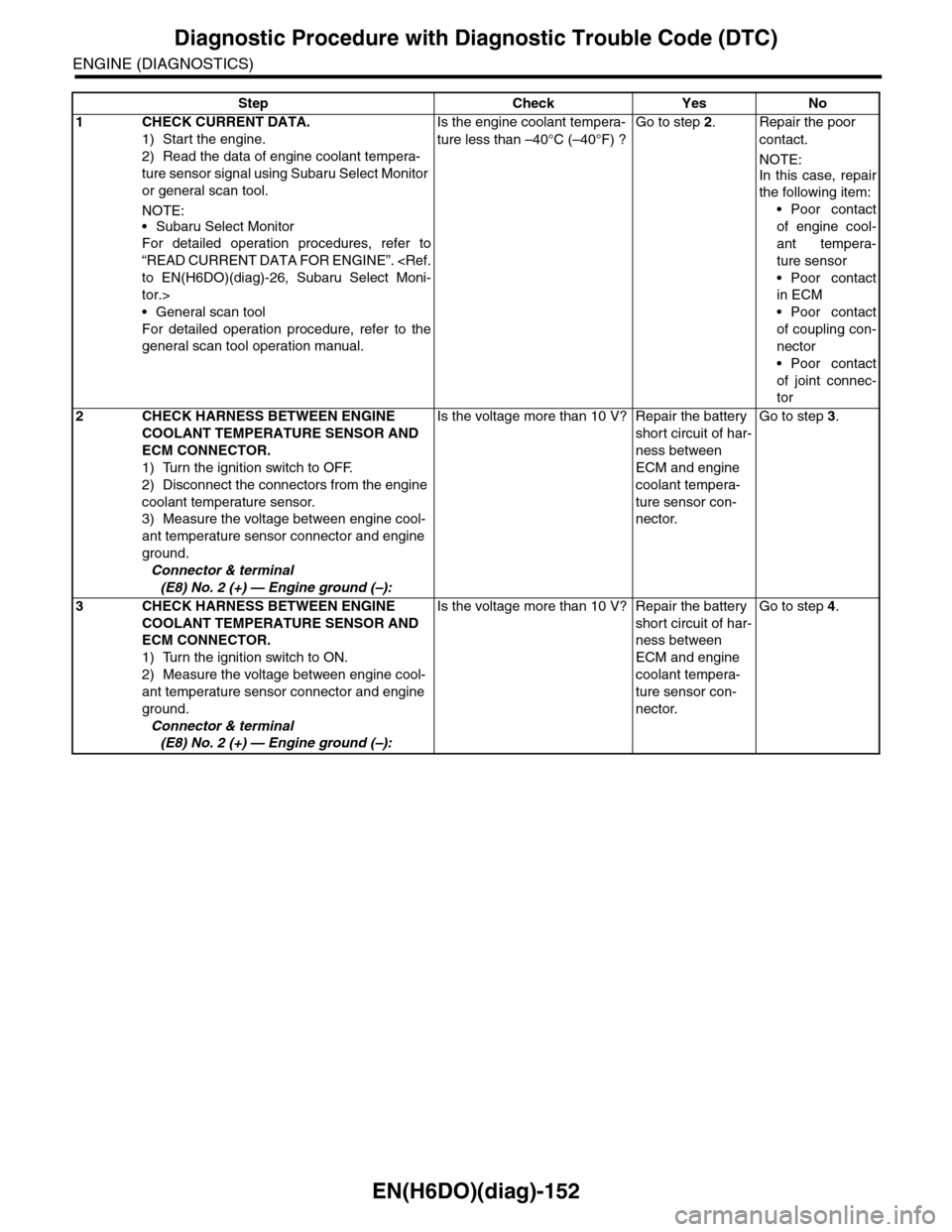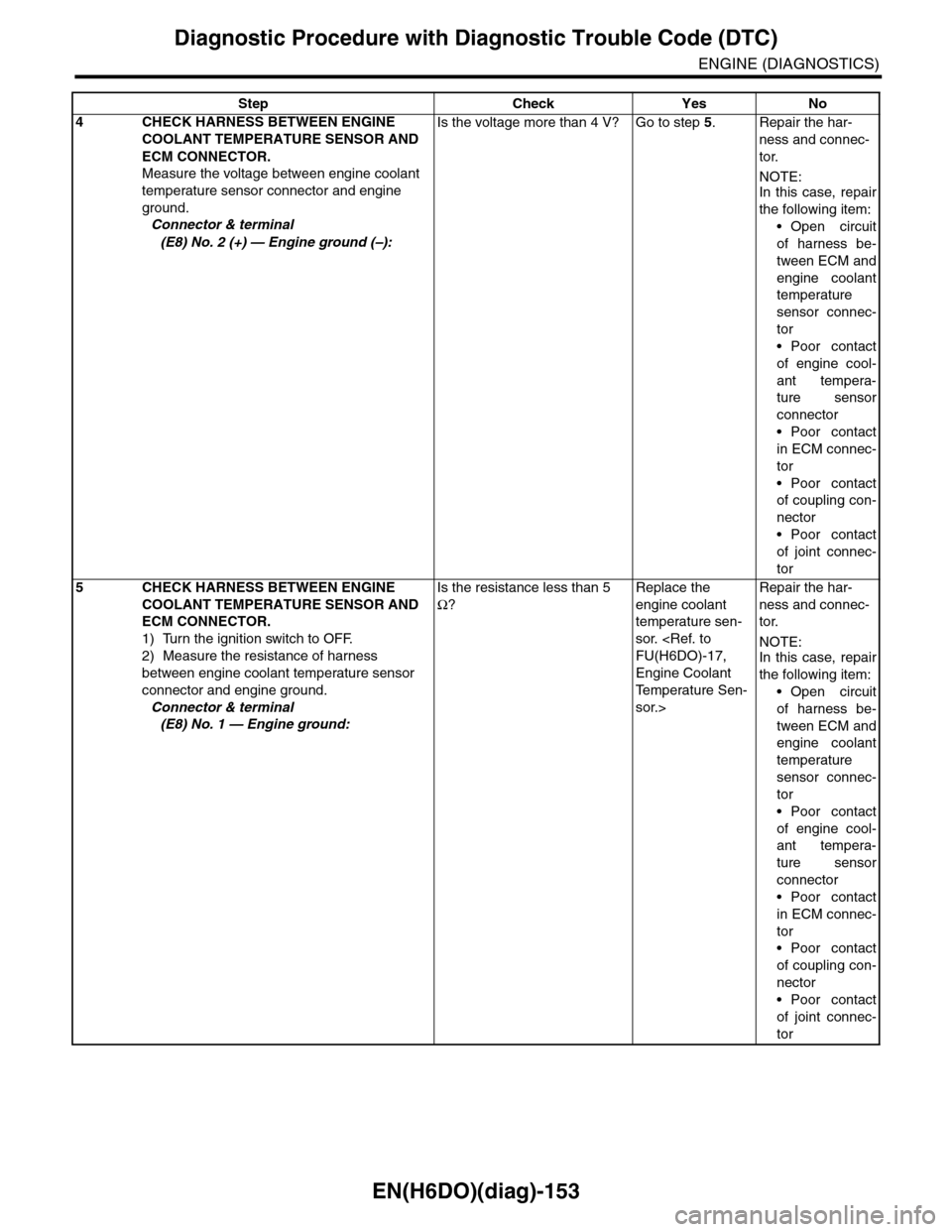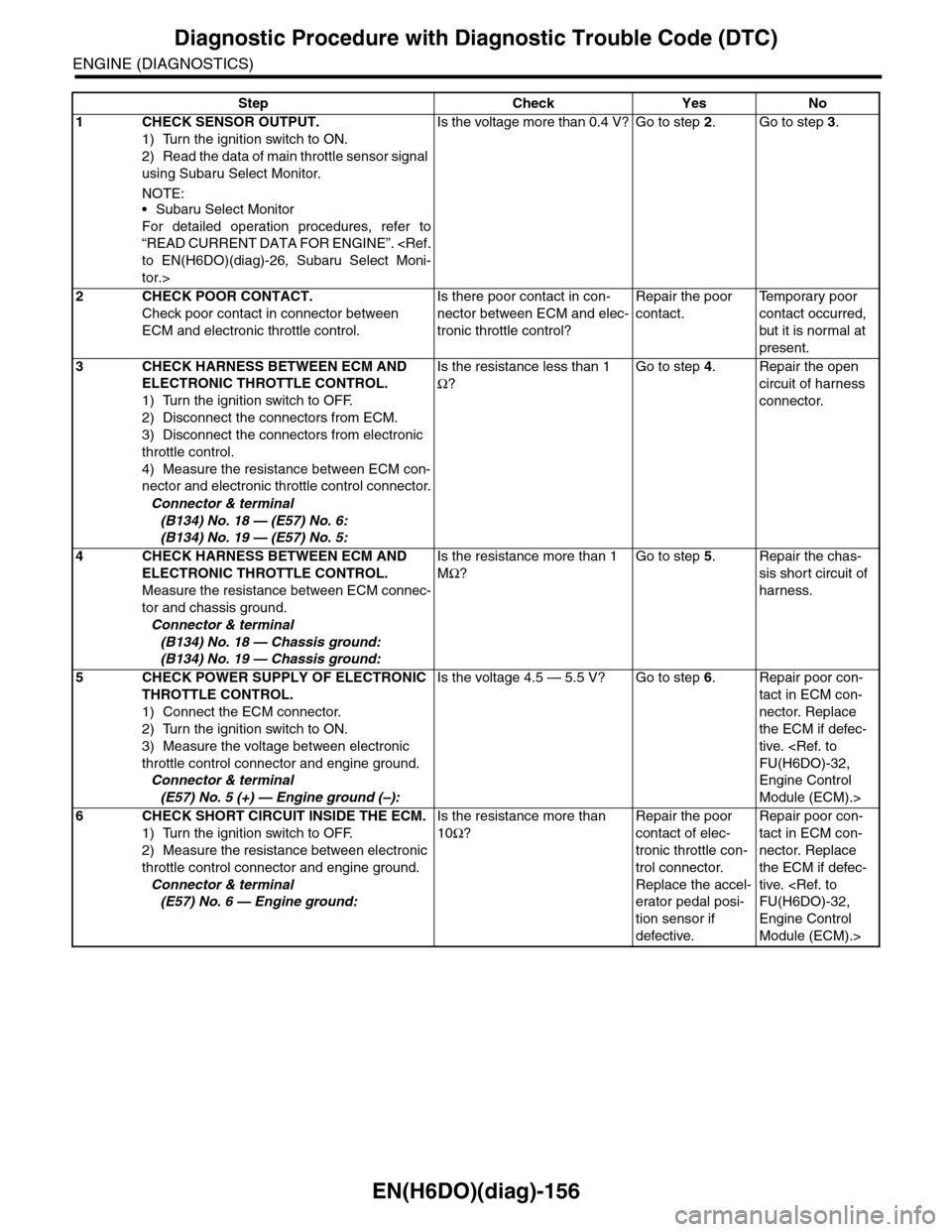Page 1313 of 2453

EN(H6DO)(diag)-152
Diagnostic Procedure with Diagnostic Trouble Code (DTC)
ENGINE (DIAGNOSTICS)
Step Check Yes No
1CHECK CURRENT DATA.
1) Start the engine.
2) Read the data of engine coolant tempera-
ture sensor signal using Subaru Select Monitor
or general scan tool.
NOTE:
•Subaru Select Monitor
For detailed operation procedures, refer to
“READ CURRENT DATA FOR ENGINE”.
to EN(H6DO)(diag)-26, Subaru Select Moni-
tor.>
•General scan tool
For detailed operation procedure, refer to the
general scan tool operation manual.
Is the engine coolant tempera-
ture less than –40°C (–40°F) ?
Go to step 2.Repair the poor
contact.
NOTE:
In this case, repair
the following item:
•Poor contact
of engine cool-
ant tempera-
ture sensor
•Poor contact
in ECM
•Poor contact
of coupling con-
nector
•Poor contact
of joint connec-
tor
2CHECK HARNESS BETWEEN ENGINE
COOLANT TEMPERATURE SENSOR AND
ECM CONNECTOR.
1) Turn the ignition switch to OFF.
2) Disconnect the connectors from the engine
coolant temperature sensor.
3) Measure the voltage between engine cool-
ant temperature sensor connector and engine
ground.
Connector & terminal
(E8) No. 2 (+) — Engine ground (–):
Is the voltage more than 10 V? Repair the battery
short circuit of har-
ness between
ECM and engine
coolant tempera-
ture sensor con-
nector.
Go to step 3.
3CHECK HARNESS BETWEEN ENGINE
COOLANT TEMPERATURE SENSOR AND
ECM CONNECTOR.
1) Turn the ignition switch to ON.
2) Measure the voltage between engine cool-
ant temperature sensor connector and engine
ground.
Connector & terminal
(E8) No. 2 (+) — Engine ground (–):
Is the voltage more than 10 V? Repair the battery
short circuit of har-
ness between
ECM and engine
coolant tempera-
ture sensor con-
nector.
Go to step 4.
Page 1314 of 2453

EN(H6DO)(diag)-153
Diagnostic Procedure with Diagnostic Trouble Code (DTC)
ENGINE (DIAGNOSTICS)
4CHECK HARNESS BETWEEN ENGINE
COOLANT TEMPERATURE SENSOR AND
ECM CONNECTOR.
Measure the voltage between engine coolant
temperature sensor connector and engine
ground.
Connector & terminal
(E8) No. 2 (+) — Engine ground (–):
Is the voltage more than 4 V? Go to step 5.Repair the har-
ness and connec-
tor.
NOTE:In this case, repair
the following item:
•Open circuit
of harness be-
tween ECM and
engine coolant
temperature
sensor connec-
tor
•Poor contact
of engine cool-
ant tempera-
ture sensor
connector
•Poor contact
in ECM connec-
tor
•Poor contact
of coupling con-
nector
•Poor contact
of joint connec-
tor
5CHECK HARNESS BETWEEN ENGINE
COOLANT TEMPERATURE SENSOR AND
ECM CONNECTOR.
1) Turn the ignition switch to OFF.
2) Measure the resistance of harness
between engine coolant temperature sensor
connector and engine ground.
Connector & terminal
(E8) No. 1 — Engine ground:
Is the resistance less than 5
Ω?
Replace the
engine coolant
temperature sen-
sor.
FU(H6DO)-17,
Engine Coolant
Te m p e r a t u r e S e n -
sor.>
Repair the har-
ness and connec-
tor.
NOTE:In this case, repair
the following item:
•Open circuit
of harness be-
tween ECM and
engine coolant
temperature
sensor connec-
tor
•Poor contact
of engine cool-
ant tempera-
ture sensor
connector
•Poor contact
in ECM connec-
tor
•Poor contact
of coupling con-
nector
•Poor contact
of joint connec-
tor
Step Check Yes No
Page 1315 of 2453
EN(H6DO)(diag)-154
Diagnostic Procedure with Diagnostic Trouble Code (DTC)
ENGINE (DIAGNOSTICS)
AF:DTC P0122 THROTTLE/PEDAL POSITION SENSOR/SWITCH “A” CIRCUIT
LOW INPUT
DTC DETECTING CONDITION:
•Immediately at fault recognition
•GENERAL DESCRIPTION
SOR/SWITCH “A” CIRCUIT LOW INPUT, Diagnostic Trouble Code (DTC) Detecting Criteria.>
TROUBLE SYMPTOM:
•Erroneous idling
•Engine stalls.
•Poor driving performance
Page 1316 of 2453
EN(H6DO)(diag)-155
Diagnostic Procedure with Diagnostic Trouble Code (DTC)
ENGINE (DIAGNOSTICS)
WIRING DIAGRAM:
EN-03739
SBF-7
B134A:B137B136D:
B362
E1
B20
C:E
EE
C1C21
38392019
1615
*
*
E2
B21
E57
461235
D4D5A29A19A5D3D7A3D2D1
3536375234
A28A18C6
ECM
57
86
B362
12
78
34
56
B21
12345678910 1112 1314 1516 1718 1920 21222324 25
34 35 36 37 38 39 40 41
48 49 50 51 52 53 5442 43 44 45 46 47
26 2728 2930 313233
B122
12345678
1289563410 11 121920 2129 3031
13 14 15161727281822 2324 25 267
32 3334 35
B136C:
12789563410 11 121920 2129 30 31
13 14 151617
27 281822 23 24 2526
B137D:
BATTERY
MAIN RELAY
ELECTRONICTHROTTLECONTROL RELAY
ELECTRONICTHROTTLE CONTROL
B20
1234567891011 121314 15 16
E57
123456
B122
*: TERMINAL NO. OPTIONAL ARRANGEMENT
A:B134
85610 11 12 13 14 157213416
3019 20 2228 29
91718252123 24323126 2733 34
Page 1317 of 2453

EN(H6DO)(diag)-156
Diagnostic Procedure with Diagnostic Trouble Code (DTC)
ENGINE (DIAGNOSTICS)
Step Check Yes No
1CHECK SENSOR OUTPUT.
1) Turn the ignition switch to ON.
2) Read the data of main throttle sensor signal
using Subaru Select Monitor.
NOTE:•Subaru Select Monitor
For detailed operation procedures, refer to
“READ CURRENT DATA FOR ENGINE”.
to EN(H6DO)(diag)-26, Subaru Select Moni-
tor.>
Is the voltage more than 0.4 V? Go to step 2.Go to step 3.
2CHECK POOR CONTACT.
Check poor contact in connector between
ECM and electronic throttle control.
Is there poor contact in con-
nector between ECM and elec-
tronic throttle control?
Repair the poor
contact.
Te m p o r a r y p o o r
contact occurred,
but it is normal at
present.
3CHECK HARNESS BETWEEN ECM AND
ELECTRONIC THROTTLE CONTROL.
1) Turn the ignition switch to OFF.
2) Disconnect the connectors from ECM.
3) Disconnect the connectors from electronic
throttle control.
4) Measure the resistance between ECM con-
nector and electronic throttle control connector.
Connector & terminal
(B134) No. 18 — (E57) No. 6:
(B134) No. 19 — (E57) No. 5:
Is the resistance less than 1
Ω?
Go to step 4.Repair the open
circuit of harness
connector.
4CHECK HARNESS BETWEEN ECM AND
ELECTRONIC THROTTLE CONTROL.
Measure the resistance between ECM connec-
tor and chassis ground.
Connector & terminal
(B134) No. 18 — Chassis ground:
(B134) No. 19 — Chassis ground:
Is the resistance more than 1
MΩ?
Go to step 5.Repair the chas-
sis short circuit of
harness.
5CHECK POWER SUPPLY OF ELECTRONIC
THROTTLE CONTROL.
1) Connect the ECM connector.
2) Turn the ignition switch to ON.
3) Measure the voltage between electronic
throttle control connector and engine ground.
Connector & terminal
(E57) No. 5 (+) — Engine ground (–):
Is the voltage 4.5 — 5.5 V? Go to step 6.Repair poor con-
tact in ECM con-
nector. Replace
the ECM if defec-
tive.
FU(H6DO)-32,
Engine Control
Module (ECM).>
6CHECK SHORT CIRCUIT INSIDE THE ECM.
1) Turn the ignition switch to OFF.
2) Measure the resistance between electronic
throttle control connector and engine ground.
Connector & terminal
(E57) No. 6 — Engine ground:
Is the resistance more than
10Ω?
Repair the poor
contact of elec-
tronic throttle con-
trol connector.
Replace the accel-
erator pedal posi-
tion sensor if
defective.
Repair poor con-
tact in ECM con-
nector. Replace
the ECM if defec-
tive.
FU(H6DO)-32,
Engine Control
Module (ECM).>
Page 1318 of 2453
EN(H6DO)(diag)-157
Diagnostic Procedure with Diagnostic Trouble Code (DTC)
ENGINE (DIAGNOSTICS)
AG:DTC P0123 THROTTLE/PEDAL POSITION SENSOR/SWITCH “A” CIRCUIT
HIGH INPUT
DTC DETECTING CONDITION:
•Immediately at fault recognition
•GENERAL DESCRIPTION
SOR/SWITCH “A” CIRCUIT HIGH INPUT, Diagnostic Trouble Code (DTC) Detecting Criteria.>
TROUBLE SYMPTOM:
•Erroneous idling
•Engine stalls.
•Poor driving performance
Page 1319 of 2453
EN(H6DO)(diag)-158
Diagnostic Procedure with Diagnostic Trouble Code (DTC)
ENGINE (DIAGNOSTICS)
WIRING DIAGRAM:
EN-03739
SBF-7
B134A:B137B136D:
B362
E1
B20
C:E
EE
C1C21
38392019
1615
*
*
E2
B21
E57
461235
D4D5A29A19A5D3D7A3D2D1
3536375234
A28A18C6
ECM
57
86
B362
12
78
34
56
B21
12345678910 1112 1314 1516 1718 1920 21222324 25
34 35 36 37 38 39 40 41
48 49 50 51 52 53 5442 43 44 45 46 47
26 2728 2930 313233
B122
12345678
1289563410 11 121920 2129 3031
13 14 15161727281822 2324 25 267
32 3334 35
B136C:
12789563410 11 121920 2129 30 31
13 14 151617
27 281822 23 24 2526
B137D:
BATTERY
MAIN RELAY
ELECTRONICTHROTTLECONTROL RELAY
ELECTRONICTHROTTLE CONTROL
B20
1234567891011 121314 15 16
E57
123456
B122
*: TERMINAL NO. OPTIONAL ARRANGEMENT
A:B134
85610 11 12 13 14 157213416
3019 20 2228 29
91718252123 24323126 2733 34
Page 1320 of 2453

EN(H6DO)(diag)-159
Diagnostic Procedure with Diagnostic Trouble Code (DTC)
ENGINE (DIAGNOSTICS)
Step Check Yes No
1CHECK SENSOR OUTPUT.
1) Turn the ignition switch to ON.
2) Read the data of main throttle sensor signal
using Subaru Select Monitor.
NOTE:•Subaru Select Monitor
For detailed operation procedures, refer to
“READ CURRENT DATA FOR ENGINE”.
to EN(H6DO)(diag)-26, Subaru Select Moni-
tor.>
Is the voltage less than 4.63
V?
Go to step 2.Go to step 3.
2CHECK POOR CONTACT.
Check poor contact in connector between
ECM and electronic throttle control.
Is there poor contact in con-
nector between ECM and elec-
tronic throttle control?
Repair the poor
contact.
Te m p o r a r y p o o r
contact occurred,
but it is normal at
present.
3CHECK HARNESS BETWEEN ECM AND
ELECTRONIC THROTTLE CONTROL.
1) Turn the ignition switch to OFF.
2) Disconnect the connectors from ECM.
3) Disconnect the connectors from electronic
throttle control.
4) Measure the resistance between ECM con-
nector and electronic throttle control connector.
Connector & terminal
(B134) No. 18 — (E57) No. 6:
(B134) No. 29 — (E57) No. 3:
Is the resistance less than 1
Ω?
Go to step 4.Repair the open
circuit of harness
connector.
4CHECK HARNESS BETWEEN ECM AND
ELECTRONIC THROTTLE CONTROL.
1) Connect the ECM connector.
2) Measure the resistance between electronic
throttle control connector and engine ground.
Connector & terminal
(E57) No. 3 — Engine ground:
Is the resistance less than 5
Ω?
Go to step 5.Repair poor con-
tact in ECM con-
nector. Replace
the ECM if defec-
tive.
FU(H6DO)-32,
Engine Control
Module (ECM).>
5CHECK SENSOR OUTPUT POWER SUP-
PLY.
Measure the voltage between electronic throt-
tle control connector and engine ground.
Connector & terminal
(E57) No. 6 (+) — Engine ground (–):
Is the voltage less than 10 V? Replace the elec-
tronic throttle con-
trol.
FU(H6DO)-11,
Throttle Body.>
Repair the battery
short circuit of har-
ness between
ECM connector
and electronic
throttle control
connector.